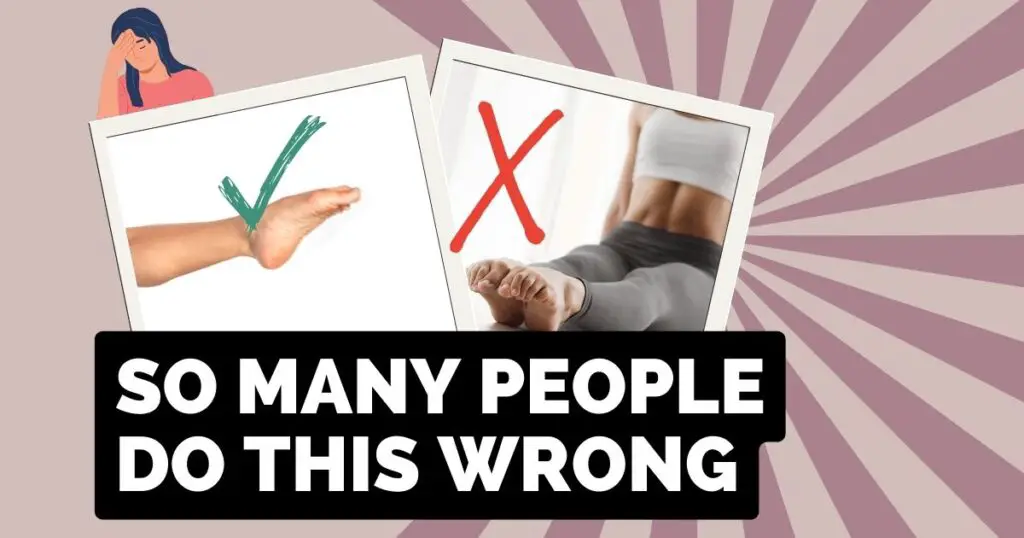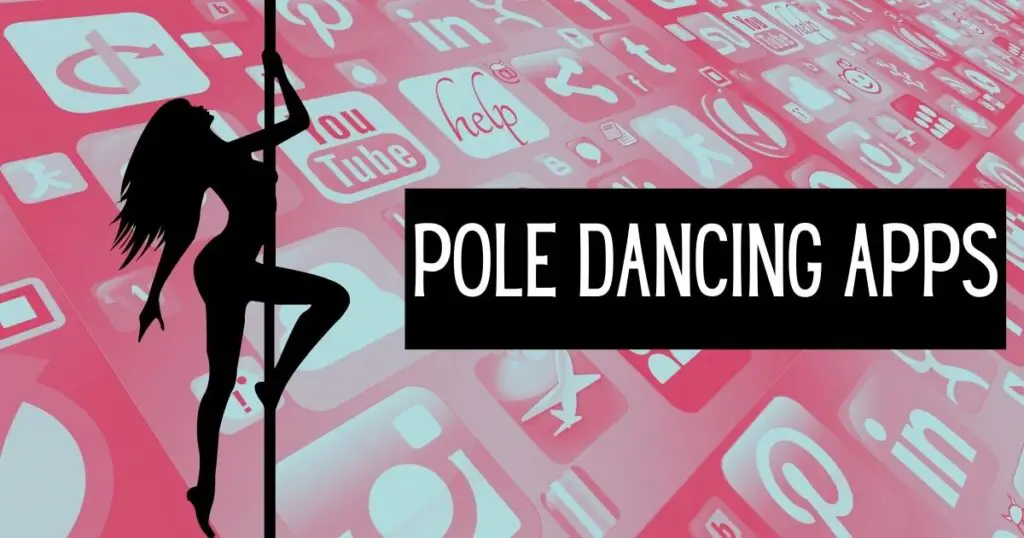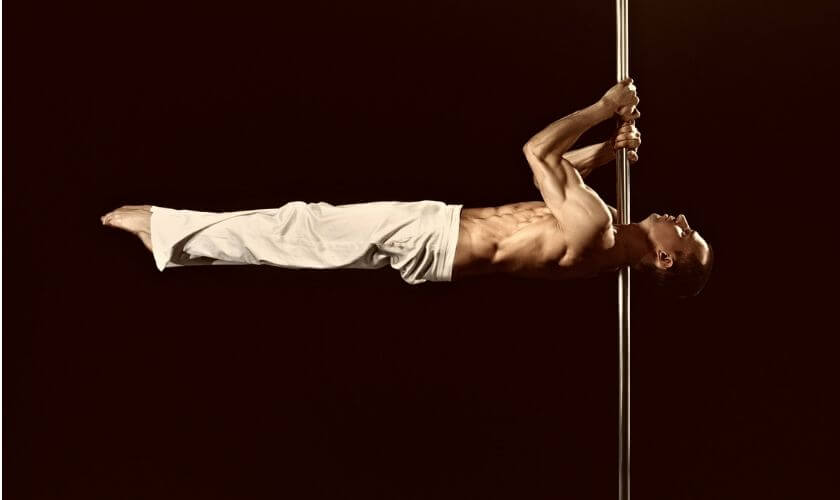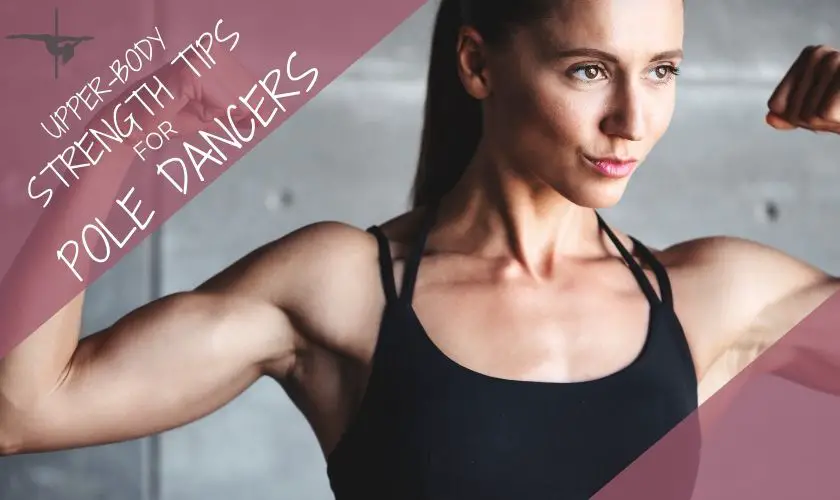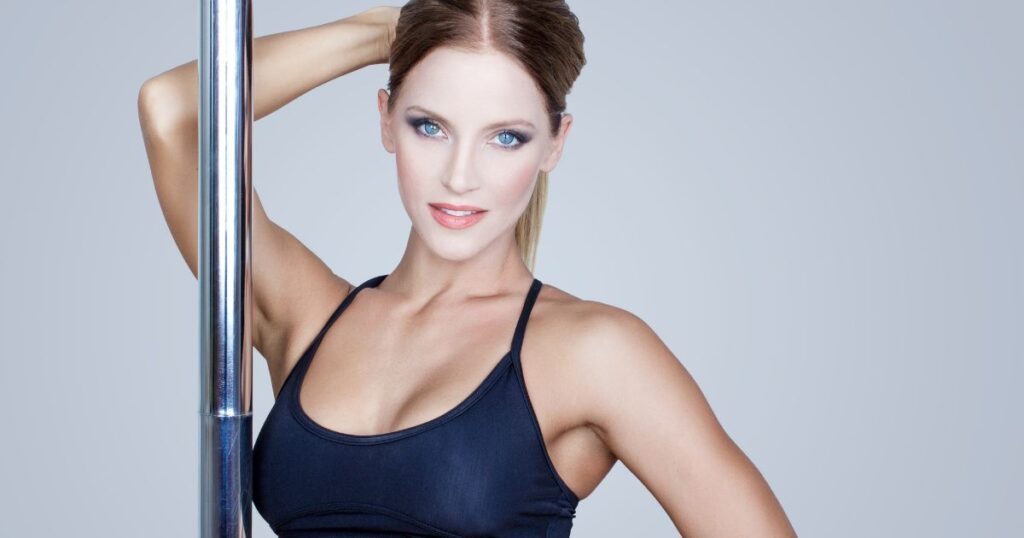Pointing your toes is required for pole dancing. Having pointed toes makes your lines appear cleaner and more aesthetic.
As a pole dance instructor, I’ve had to yell out “point those damn toes” more than I could possibly count! Which I’ll admit, is probably quite jarring for a student who is semi-inverted at the time!
In this article, we will be discussing the importance of pointing your toes in pole dancing.
As pole dancers, we often focus on our upper body strength and flexibility, but it is important to not overlook the role that our feet and toes play in our routines.
By pointing your toes, you can improve the aesthetic of your dance and also increase your stability and control on the pole.
By reading this guide, you will learn:
- Which muscle groups are engaged when you point your toes
- Why having pointed toes is important for pole dancers as well as other athletes and performers
- How to deal with foot cramps when pointing your toes
- The correct technique for achieving a beautiful arched foot when pointing your toes, both on and off the pole.
We will go over some tips and techniques for how to point your toes effectively in your pole dancing practice.
So let’s talk about how to point your toes properly.
Pointing your toes correctly is an important part of many different dance styles, and it can also improve your posture and balance. In order to point your toes properly, there are a few key concepts that you need to understand.
First, you need to know how to engage your foot muscles.
Second, you need to understand the proper alignment for your feet.
And third, you need to practice good technique in order to maintain the proper position.
We’ll go over all of these concepts in more detail in the rest of this post, so let’s get started and help you achieve a beautiful toe point!
Who Needs To Point Their Toes?
Many sports and performing arts require athletes/performers to point their toes in order to perform certain moves or techniques.
For example:
Ballet: dancers must point their toes in order to execute certain ballet positions and movements.
Figure skating: pointing the toes is important for creating clean lines and smooth movements on the ice.
Diving: pointing the toes can help a diver achieve a better entry into the water.
Gymnastics: pointing the toes can improve the aesthetic of a routine and help the gymnast achieve a higher score in competitions.
Modern Dance: dancers point their toes to achieve cleaner lines and a more polished finish to their routines.
Yoga: Yogis point their toes in certain poses to stretch and relax certain muscles during yoga class or workout sessions at home.
Pole dancing: pole dancers point their toes during pole performances and routines because it looks elegant and engages muscles in your lower legs
Pointed Toes vs Flexed Toes
In general, pointed toes refer to the toes being extended, or straightened, so that the foot forms a long, thin line.
Having a pointed foot refers to the same thing as having pointed toes.
Flexed toes, on the other hand, refer to the toes being curled upward. The muscles of your foot are engaged in a different way.
The position of the toes and feet can affect the overall appearance and alignment of the body when dancing, and it can also impact the way that the dancer moves and performs certain steps.
What Muscles Groups Are Used To Point Your Toes
Pointing your toes is more than simply engaging your toes into position!
You actually use your entire foot and much of your lower leg too.
Shoes with a high heel exist because they elongate your lower legs and make your calves appear more toned. That’s because the sheer act of walking in stiletto heels is a workout!
Also, because high heel shoes engage the same muscle groups as you do when pointing your toes. It gives a very similar appearance in your calves.
Walking in high heel shoes (or stripper shoes, if you’re feeling adventurous) mimics the position of walking with pointed toes!
When you point your toes, you primarily engage the muscles in your feet and ankles. These muscles, including the tibialis anterior, the flexor digitorum longus, and the flexor hallucis longus, work together to allow you to flex your toes and extend your foot.
In addition, other muscles in your calves, shins, and thighs may also play a role in helping you maintain your balance and alignment when you point your toes.
It’s important to engage these muscles correctly in order to point your toes properly and avoid strain or injury.
Foot Stretches for Better Pointed Toes
Performing these stretches regularly can help improve flexibility and strength in your feet, which can be beneficial for pole dancers wanting to improve the appearance and lines of their pointed toes.
It is important to listen to your body and not push yourself too far, and to stop if you feel any pain or discomfort.
1. Toe Flexion
This stretch involves sitting on the floor with your legs extended in front of you, and using your hands to gently pull your toes back towards your body to stretch the muscles in the bottom of your feet.
Hold the stretch for a maximum of 20-30 seconds, then repeat as required.
2. Toe Extension
This stretch involves sitting on the floor with your legs extended in front of you, and using your hands to gently push your toes away from your body to stretch the muscles on the top of your feet.
Hold the stretch for a maximum of 20-30 seconds, then repeat as required.
3. Foot Arch Stretch
This stretch involves standing with your feet shoulder-width apart, and using a towel or a resistance band to gently pull your toes back towards your body to stretch the muscles in your arches.
Hold the stretch for a maximum of 20-30 seconds, then repeat as required.
4. Heel Cord Stretch
This stretch involves standing with your feet shoulder-width apart, and gently rising up onto your toes to stretch the muscles in your calf and heel cord.
Hold the stretch for a maximum of 20-30 seconds, then repeat as required.
The Correct Way Achieve Pointed Toes
First of all, imagine pointing your fingers. Now, translate that motion from your hands to your feet.
When instructed to point your toes, it’s common for pole dance students to curl their big toe inward, but this doesn’t give the intended affect and can also increase the risk of cramp (more on that later…)
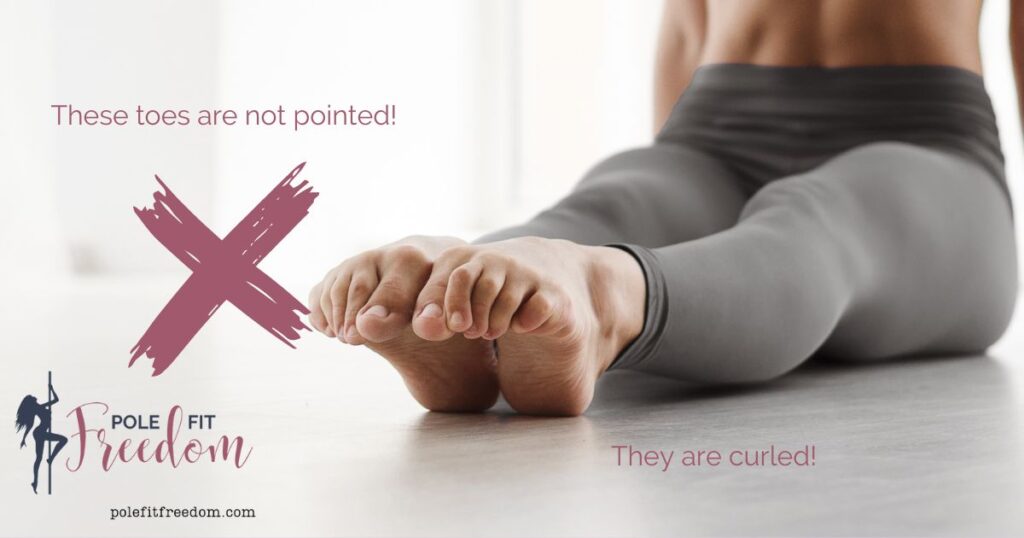
If you were pointing your fingers, would you curl them inward toward your palm?
No.
You would point your fingers straight out.
Imagine that you’re pointing at an object in the room with your toes!
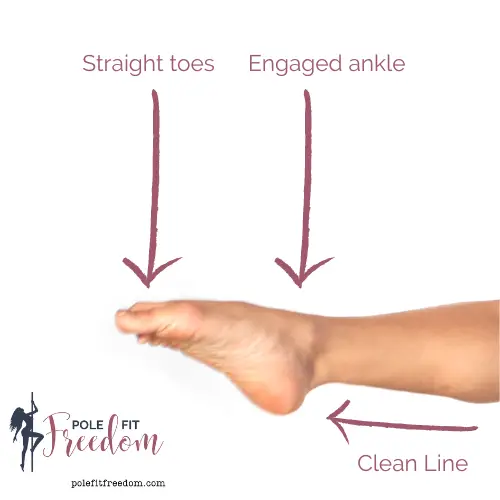
Want to become an amazing pole dancer?
Open Dance Academy has over 450 online lessons, by some world famous pole dancing champions! Join now to get:
***GET 10% OFF OPEN DANCE ACADEMY***
Use the code polefitfreedom to get 10% off Pole Dancing Lessons with Open Dance Academy. This is an exclusive offer for readers of this blog!
Here are a few more details on the steps outlined here:
Step 1: Start With Your Foot Relaxed In Its Natural Position
Before you start trying to point your toes, it’s important to start with your foot in a relaxed position.
This will help you get a feel for the natural alignment of your foot, and it will also allow you to engage the correct muscles without straining.
To start, sit or stand in a comfortable position, and let your feet fall naturally to the floor.
Take a few moments to breathe and relax, and allow your feet to rest in their natural position.
Step 2: Start To Tense Your Ankle
Once your foot is relaxed, you can start to engage the muscles in your ankle.
To do this, try gently flexing your ankle by pulling your toes back towards your shin.
This will help activate the muscles in your foot and ankle, and it will also help you maintain balance and control as you move on to the next step.
Step 3: Extend Your Foot
Now you can start to extend your foot forward in preparation for the actual toe point.
Remember, imagine that you are aiming to point at an object somewhere in your room or dance studio using your toes!
Step 4: Point Your Toes
Now that your ankle is engaged, you can start to point your toes.
To do this, extend your toes away from your foot, and try to create a long, thin line with your foot. This will require you to use the muscles in your foot and ankle to flex and extend your toes, so make sure to engage these muscles correctly to avoid strain or injury.
As you point your toes, try to maintain good alignment and balance, and focus on creating a smooth, fluid movement.
Step 5: Hold The Position and Gently Release
When you release your pointed toes back to their natural, relaxed position, it’s important that you do this gently and slowly or the sudden change in tension can trigger intense cramps for some people.
Remember, achieving better pointed toes takes time and practice.
Don’t be discouraged if you don’t get it right away – just keep practicing and focusing on engaging the correct muscles and maintaining good technique.
With dedication and practice, you’ll be able to improve your pointed toes and enhance your overall dance performance.
Tips To Consider When Pointing Your Toes
Here are few additional tips to keep in mind.
- Try not to let your ankle point inwards or outwards. Imagine a straight line from your knee to your big toe – this line should not veer off in either direction. I find that my ankles naturally point inwards so I have to consciously correct that.
- Point your toes when you’re performing other stretches. Learning how to achieve perfect pointed toes doesn’t have to be done in isolation. You can work on your foot arch at the same time as working on other stretches and poses.
- Look after your feet. You probably don’t give your feet at much attention as they deserve! When you’re spending a lot of time looking at your feet during pole practice, it can boost your mood slightly if you’ve had a recent pedicure.
How To Ease Cramp When Pointing Your Toes
Frustratingly, cramp is very common when holding your toes in a pointed position. It’s actually a scary sensation as it feels like your toes are getting ‘locked’ from within!
If you start to feel cramps when pointing your toes, gentle release tension in your ankle to loosen the position.
Try to stretch your foot in the opposite direction, but do so gently so you don’t cause yourself further discomfort.
There are few others you could try to ease your foot cramps, such as:
Foot Massager Ball
These little spikey foot massaging balls look a bit like torture devices! But they really do sooth your aching, cramping feet with gentle pressure applied.
You can also use a tennis ball for a similar effect.
Shiatsu Massager for Feet
This digital shiatsu massager for your feet is a gamechanger for those of you who experience extreme foot cramps when pointing your toes.
You can also use this on your lower back or your hands for extra pain-relieving value.
Pointed Toes: Summary
Learning how to point your toes properly is an important skill for dancers of all levels.
By understanding the key concepts involved, such as how to engage the correct muscles in your feet and ankles, how to maintain proper alignment, and how to practice good technique, you can improve your pointed toes and enhance your overall dance performance.
Remember to start with your foot relaxed in its natural position, engage your ankle muscles, and then extend your toes to create a long, thin line.
With dedication and practice, you’ll be able to master the art of pointing your toes and take your dancing to the next level.
Related Posts
If you enjoyed this, you’ll also like:
- 15 Awesome Stretches For Pole Dancers
- Best Dance Poles For Home Use
- How To Get More Flexible In No Time
- 7 Unique Aerial Sports To Try Today
- Is Pole Dancing A Sport Or An Artform? Or Both?
- Can You Pole Dance During Your Period?
- 5 Ways To Recover From Sore Muscles After Pole Dancing
- Does Pole Dancing Improve Your Sex Life?

